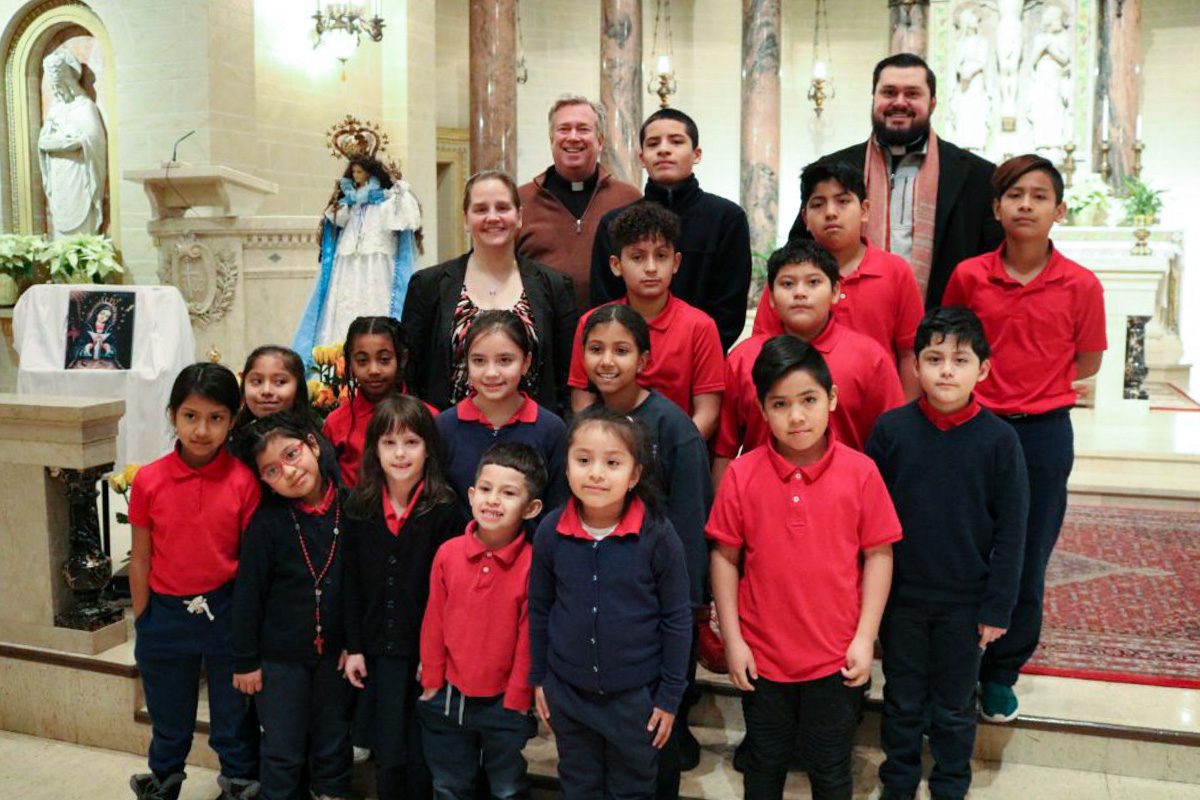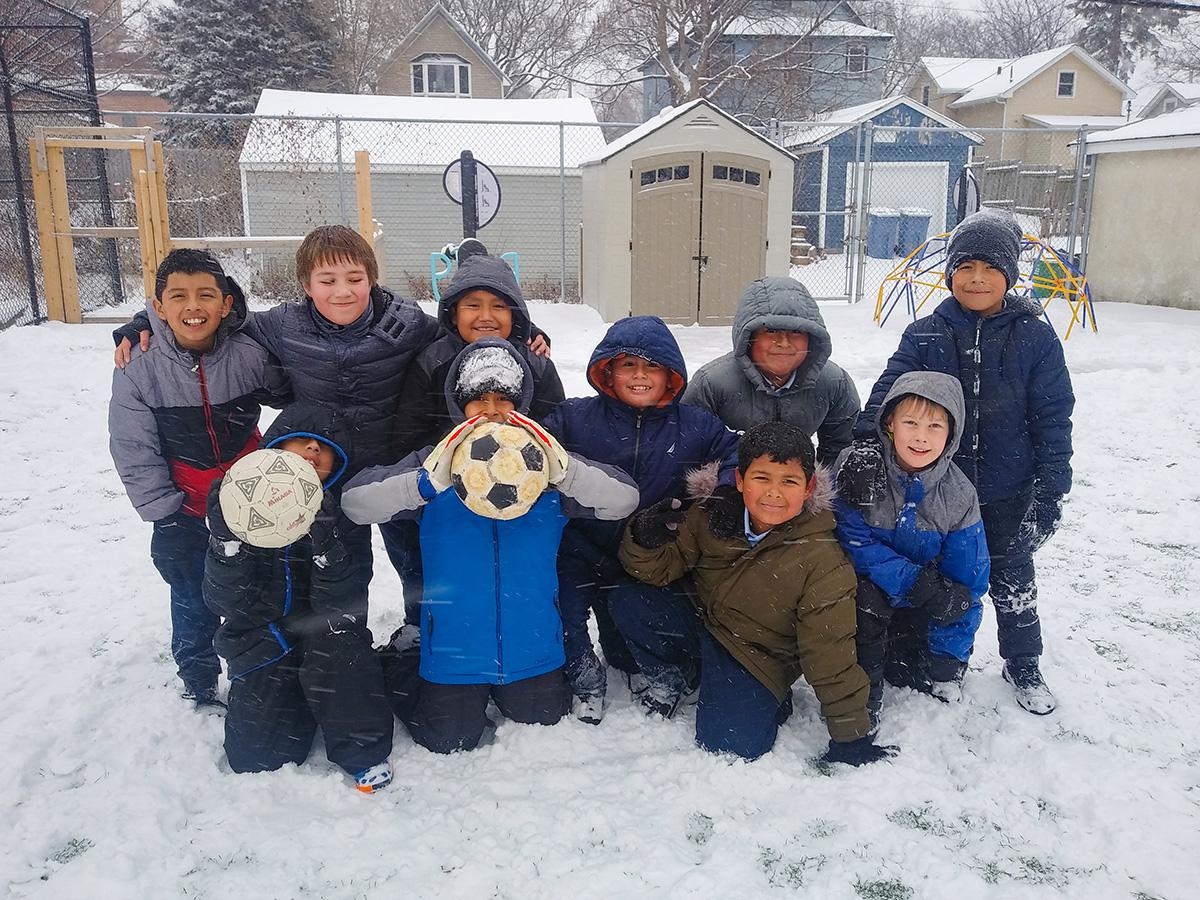The United States is home to more immigrants than any other country in the world. Students who come to the U.S. bring the gift of their home language, but they also face challenges in learning to navigate new classrooms and ways of life as they learn a new language.
For educators, this poses a critical question: When a student who has recently moved to the U.S. enrolls in your school, how do you welcome them and give them a quality educational experience? Tricia Menzhuber, the principal of St. John Paul II Catholic School in Minneapolis, Minnesota, and her teachers are working to answer this question and to answer Christ’s call to welcome the stranger.
“In my second year at St. John Paul II, we had one new-to-country student who was in eighth grade, and we were asking, ‘What do we do?’” Menzhuber says.
St. John Paul II’s population is largely Spanish-speaking families, and the school had access to translators. In the 2019–20 school year, the school had only one new-to-country student. This year, there are 36 new-to-country students enrolled at St. John Paul II. As the number of English learners continues to grow every year, Menzhuber’s challenge is figuring out how to expand the supports that they are offering to students.
“We’re adding about 30 students a year, and of those 30 children, 25 speak Spanish natively and five have just arrived in the country,” Menzhuber says. “We’re trying to figure out how to system up all of our [English learner, or EL] supports, and our teachers are learning a lot.”
When Menzhuber needed support, she reached out to the ACE English as a New Language team, part of the Catholic School Advantage, at the University of Notre Dame.
“I was telling them that I just didn’t know where to go, and they had a whole partner plan,” Menzhuber recalls. “They got me into the Latino Enrollment Institute and said, ‘You’re growing. You need to really pay attention to what’s happening with your parent culture.’”
Since Menzhuber participated in the year-long institute, she has continued to work with ACE’s Catholic School Advantage team to find further professional development opportunities for her teachers and staff.
“A lot of EL programs are designed to transition students out of them after a year . . . I didn’t like the thought of having a third grader, for example, arriving and having their first experience of American schools be an intimate community of EL supporters but then having all of that taken away after a year.”
“The Catholic School Advantage program in general has been a great partnership,” Menzhuber says. “Our school secretary, who is our family liaison, is now in the LEAD program and one of our teachers is an ENL Hernandez Fellow.”
While these partnerships have provided a great source of support, Menzhuber and her faculty and staff are facing a new challenge as the number of immigrant students increases across a variety of grade levels. To navigate this new landscape, Menzhuber looked to the U.S. Department of Education for support, and spoke to Catholic School Advantage Director Katy Lichon.
“Thank God for the Department of Education,” Menzhuber says. “Their Newcomer Tool Kit has been a great resource for us. And when I told Dr. Lichon that I didn’t know what to do, she introduced me to the idea of newcomer experiences like the Newcomer Academy.”
The Newcomer Academy, based in Louisville, Kentucky, serves sixth- through 10th-grade English learners who are beginning English speakers. Many are in their first year of instruction in a U.S. school, and they transition to a different middle or high school with an ESL program after one to three semesters at the Newcomer Academy.
“A lot of EL programs are designed to transition students out of them after a year,” Menzhuber says. “I didn’t like the thought of having a third grader, for example, arriving and having their first experience of American schools be an intimate community of EL supporters but then having all of that taken away after a year.”
So what did Menzhuber and her team at St. John Paul II do? “We just invented our own thing,” Menzhuber says.
Menzhuber and her team are building what they call a Newcomer Experience, designed to support their new-to-country students as well as students who are English learners.

“We started with the three basic national Department of Education recommendations,” Menzhuber says. “We’re tackling academics, social emotional needs, and family/community support. In particular, we’re focusing on academics and social emotional pieces because we can control them a little bit better.”
One of the key things that Menzhuber has done is leverage the people and resources that she has access to. “We have a Spanish teacher who is a native speaker and an amazing instructor, so she’s been able to help us hit core content in Spanish,” Menzhuber explains. “She’s still teaching Spanish, but she’s doing it with social studies content, starting with Minnesota history.”
In addition, Menzhuber and her team have looked for ways to integrate EL instruction into other core classes.
“We also decided to use religion class as an opportunity to teach general EL skills that our English learners can add to their tool basket,” Menzhuber says. “For example, one of the things that we’re doing is teaching students how to use a tool like Google Translate to help them access the learning material.”
 While the school has a variety of resources to help support students who are native Spanish speakers, the faculty encountered a new challenge supporting the Ukrainian students that they have welcomed to school over the past year. “It’s really hard to find Ukrainian math textbooks for American curriculum,” Menzhuber says.
While the school has a variety of resources to help support students who are native Spanish speakers, the faculty encountered a new challenge supporting the Ukrainian students that they have welcomed to school over the past year. “It’s really hard to find Ukrainian math textbooks for American curriculum,” Menzhuber says.
Menzhuber and her team have taken the strategies that they have learned in working with Spanish-speaking students and are adapting them for their Ukrainian students. While no teachers at St. John Paul II speak Ukrainian, Menzhuber has still leveraged the language skills of their community to support Ukrainian students.
“Our Ukrainian students also speak Polish, so we have our Polish-speaking priest come and work with them,” Menzhuber says. “After the local news shared our story, we had a few people come forward and offer to help, including a Russian woman who can tutor in math.”
In addition to drawing on resources and support from the community, Menzhuber was also inspired by the resources that organizations such as the United Nations use, such as translation headsets.
“We were able to get translation headsets, and our teachers have committed to explaining instructions step-by-step so that students know exactly what they need to do. We also purchased Cyrillic overlays for our computer keyboards so that we can type back and forth with students,” she says.
What Menzhuber and her staff are seeing at St. John Paul II is on par with a larger trend that Lichon and the ACE English as a New Language team are seeing across the country.
“Our Catholic schools have a long and magnificent history of welcoming newcomers, and our schools continue to stand as sacred spaces where these children can belong and thrive,” Lichon says. “More and more schools are asking for resources, educational support, and social emotional learning formation for students in the first two stages of language development, and we are working to release a new set of innovative resources on this specific topic.”
While it has taken intentional planning to support students who are English learners, Menzhuber says that the steps they have taken also positively impact instruction for all students at St. John Paul II. “We’ve focused on accommodations for our newcomers, but as a school community overall we have a high population of English learners,” Menzhuber says. “And they all need supports, too. Creating our Newcomer Experience has helped us systematize our supports a little more for everybody.”
 Alliance for Catholic Education
Alliance for Catholic Education
